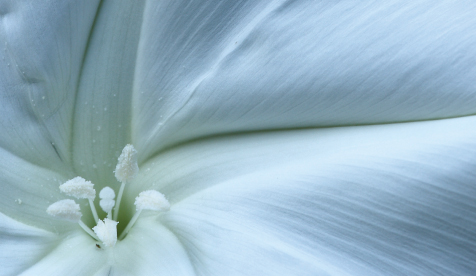Gardeners who love the sight of flower borders on a sunny day are enjoying half the pleasures the outdoor landscape has to offer during the summer months. There is also the night, and along with it, strange, mysterious plants that only bloom after the sun’s rays fade away. And arguably, the queen of the night garden is the moonvine.
Moonvine (also called “moonflower vine,” but to be sure, it is botanically known as Ipomoea alba) resembles its sun-worshipping cousin, morning glory. It is an annual vine easily capable of reaching 15 feet or more in length, and has large, fragrant, saucer-shaped flowers that rise and shine only when darkness falls.

Right Pic Caption: Left: A tightly twisted moonvine bloom waiting for evening to come.
Right: A moonvine blossom rising on a warm summer night.
Moonvine seeds (which can easily be found at most local garden shops) don’t readily germinate, but the odds of successful sprouting can be greatly improved by soaking them in water for 48 hours before planting. Scratching a small groove in its hard outer cover is a quicker way to prepare a seed for planting, and while using a metal file will work, a bench grinder can do the job even faster — just use a steady hand to barely nick the seed, not gouge it.
Mid to late May is a good time to plant moonvine because the seeds respond better to warm soil temperatures. Sow the seeds a half-inch deep in a full to partly sunny spot that has well-prepared, rich soil. Moonvines also do well in large pots. Although the vines usually start out slowly, as the summer begins to simmer, they will turn their sprout into a sprint.
Of course, for a better display, fertilize moonvines at planting time, but also add a shot of diluted organic or synthetic liquid fertilizer in mid to late July to keep the plants healthy and productive. And if you have it, maintaining fresh compost around the vines will do nothing but good things for these beauties.
The plants should be spaced about 1 to 2 feet apart and, since they are vines, locate them close to something they can climb on, such as a fence, trellis, gazebo or railing. For a little “midnight magic,” train them on strands of monofilament fishing line rated at least to 30-pound-test strength that ascend to the top of a porch or even into the branch of a tree. The nearly invisible support will give a floating effect to the vines.
Mature plants produce sweetly scented, bright white flowers 4 to 5 inches in diameter that twist open as the sun sets. The blossoms last but for a single night, but, oh, what they do with their night! You can even "tickle" the ends of the flowers in the evening to encourage them to open up right in front of you. On a moonlit night, the sight of these ghostly blooms combined with their nocturnal perfume is nothing short of enchanting. To me, the fragrance from these flowers rivals any found in daylight gardens, and as a bonus, it persists through the night. Moonvine is definitely a plant for entryways, and especially decks or porches if they are favorite places to chill out at the end of the day.
Since moonvines are closely related to morning glories, a neat garden design trick is to interplant the two, and let them tangle their way up a support, or for more flair, even add another close, day-blooming cousin, cardinal climber (Ipomoea x multifida) with its small, bright red, tubular flowers. Then, when the moonvines get through with their beautiful night shift, these sun-loving flowers can greet the new day in their own pretty way.
L.A. Jackson is the former editor of Carolina Gardener magazine.







